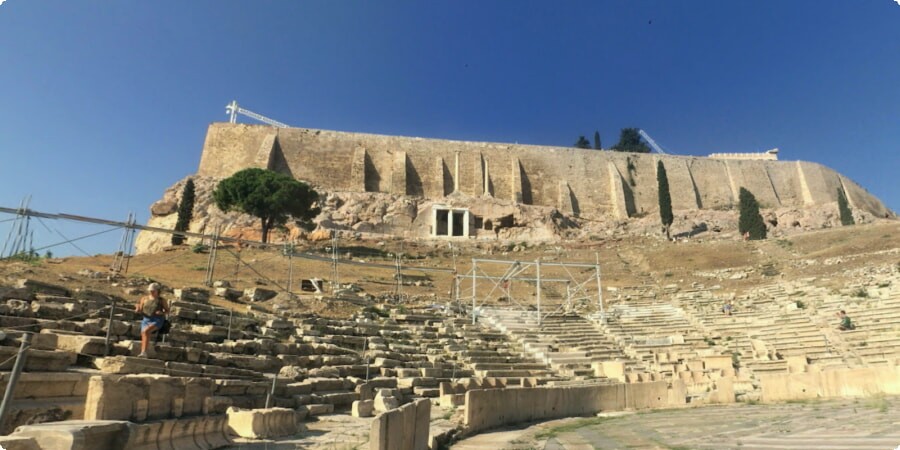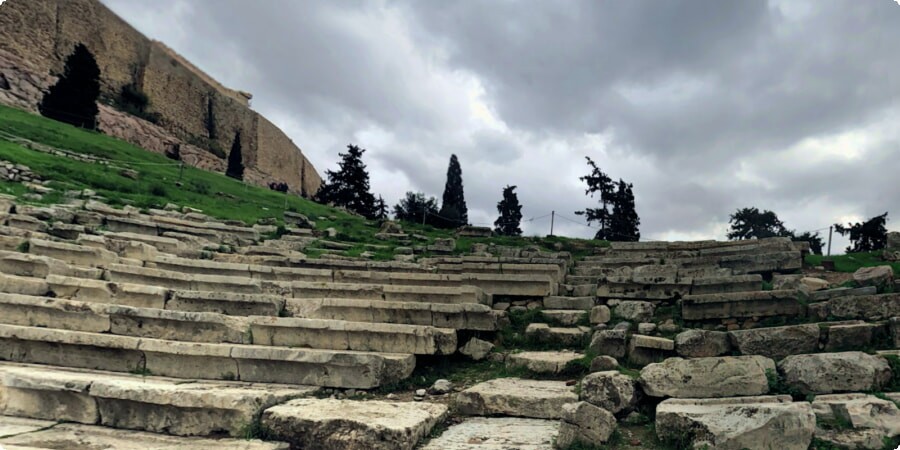Rediscovering the Theater of Dionysus: Athens' Cultural Landmark
Nestled on the southern slope of the Acropolis in Athens lies the Theater of Dionysus, a cultural landmark that played a pivotal role in the birth and evolution of ancient Greek drama. As one of the earliest and most significant theaters in history, the Theater of Dionysus stands as a testament to the artistic and cultural achievements of ancient Athens. This article embarks on a journey to rediscover the splendor and historical significance of this iconic site, exploring its origins, architectural marvels, and enduring legacy.
Historical Background
The origins of the Theater of Dionysus can be traced back to the 6th century BCE, during the reign of the Athenian ruler Peisistratos. Initially a simple, open-air venue, the theater was built to honor Dionysus, the god of wine, fertility, and theater. It was here that the City Dionysia, an annual festival dedicated to Dionysus, took place, featuring competitions in tragedy and comedy that drew playwrights, actors, and audiences from all over Greece.
As the cultural and religious heart of ancient Athens, the Theater of Dionysus played a central role in the development of Greek drama. It was in this theater that the great playwrights of antiquity—Aeschylus, Sophocles, Euripides, and Aristophanes—debuted their works, crafting stories that have endured through the centuries. These performances were not just entertainment; they were deeply intertwined with the social, political, and religious life of Athens, reflecting the values, struggles, and aspirations of its people.
Architectural Marvels
The architectural design of the Theater of Dionysus is a marvel of ancient engineering and artistic vision. Originally a wooden structure, the theater underwent several renovations and expansions over the centuries, eventually becoming a grand stone edifice capable of seating up to 17,000 spectators. The theater's semi-circular shape, known as the orchestra, provided an optimal layout for acoustics, ensuring that the voices of the actors could be heard clearly by all in attendance.

The seating arrangement, known as the cavea, was divided into tiers that reflected the social hierarchy of ancient Athens. The front rows, called the proedria, were reserved for priests, dignitaries, and other important figures, while the general populace occupied the higher tiers. The stage, or skene, was an elaborate structure that served as both a backdrop for the performances and a storage area for props and costumes.
One of the most striking features of the theater is its use of natural landscape to enhance the performance experience. The slope of the Acropolis provided a natural incline for the seating, and the backdrop of the Parthenon and other Acropolis structures added a majestic ambiance to the theatrical productions. Visitors today can still sense the grandeur and historical significance of this ancient venue. To explore the theater's location, you can check it out on Google Maps.
For those planning a visit to this iconic site, renting a car can provide the convenience and flexibility to explore Athens at your own pace. Book a car in Athens here to ensure a smooth and enjoyable travel experience.
The legacy of the Theater of Dionysus continues to inspire and captivate those who visit, offering a glimpse into the rich cultural and artistic heritage of ancient Greece. As we delve deeper into its cultural significance and modern relevance in the following sections, we will uncover the enduring impact of this extraordinary theater on the world of performing arts.
Cultural and Social Significance
The Theater of Dionysus holds immense cultural and social significance, standing as a cornerstone of ancient Greek civilization and the birthplace of Western theater. It was here that the art forms of tragedy and comedy were refined and popularized, laying the foundation for modern dramatic arts. The theater was not merely a venue for entertainment; it was a crucial part of the social and religious fabric of Athens.
During the City Dionysia festival, Athenians from all walks of life gathered to witness performances that addressed complex themes such as morality, politics, and human nature. The plays often featured gods, heroes, and mythical creatures, but they also tackled contemporary issues, providing a space for public reflection and dialogue. The theater's role in fostering civic engagement and cultural expression made it a vital institution in Athenian society.

Prominent playwrights like Aeschylus, Sophocles, and Euripides debuted their masterpieces at the Theater of Dionysus. Their works, which include "Oedipus Rex," "Antigone," and "The Bacchae," continue to be studied and performed around the world, attesting to the timeless appeal and profound impact of Greek drama. These playwrights used the theater as a platform to explore human experience, challenge societal norms, and provoke thought, leaving a lasting legacy that transcends time and geography.
Modern Rediscovery and Preservation
The journey of rediscovery and preservation of the Theater of Dionysus began in earnest in the 19th century, when archaeologists and historians started to excavate and study the site. Their efforts have unearthed a wealth of artifacts and architectural details, shedding light on the theater's history and significance. The preservation of the theater is a continuous endeavor, involving meticulous restoration work and conservation measures to protect this invaluable heritage site for future generations.
Modern archaeological studies have revealed intricate details about the theater's construction, design, and use. These findings have enhanced our understanding of ancient Greek theater and its role in society. The preservation efforts aim to maintain the structural integrity of the theater while making it accessible to visitors from around the world. The site is now a popular tourist destination, attracting scholars, students, and enthusiasts who wish to experience the birthplace of Greek drama firsthand.
Visitors can explore the ruins of the theater, imagining the grandeur of its heyday when thousands of Athenians gathered to witness the latest plays. The sense of walking in the footsteps of ancient Greeks, surrounded by the echoes of their cultural and intellectual achievements, is a powerful and evocative experience. To truly immerse in this journey, consider renting a car to explore not just Athens but other historic sites across Greece. Book a car in Greece here to enhance your travel experience.

Visitor Experience
Visiting the Theater of Dionysus offers a unique glimpse into the world of ancient Greek drama and its enduring legacy. As you step onto the ancient stones of the theater, you can almost hear the echoes of applause and the voices of actors from millennia past. The theater's location on the southern slope of the Acropolis provides stunning views of Athens, adding to the sense of awe and wonder.
When planning your visit, it's helpful to know that the theater is part of the larger Acropolis complex, which includes other significant landmarks such as the Parthenon and the Temple of Athena Nike. Arriving early can help you avoid the crowds and fully appreciate the serenity and majesty of the site. Guided tours are available, offering insights into the history, architecture, and cultural significance of the theater.
In addition to the theater itself, the surrounding area is rich with historical and cultural attractions. The Acropolis Museum, located nearby, houses an impressive collection of artifacts from the Acropolis, providing context and deeper understanding of the ancient world. Exploring the vibrant Plaka neighborhood, with its narrow streets, traditional tavernas, and artisan shops, offers a delightful contrast to the ancient ruins.
For a seamless visit, consider booking accommodations that allow you to fully experience the charm and history of Athens. Whether you prefer a luxury hotel with modern amenities or a cozy guesthouse with local character, finding the right place to stay can enhance your travel experience. Browse hotels in Athens here to find the perfect accommodation for your journey into the heart of ancient Greek culture.
A visit to the Theater of Dionysus is not just a step back in time; it's an opportunity to connect with the cultural and intellectual heritage that has shaped the world we live in today. As you explore this remarkable site, you will gain a deeper appreciation for the artistry, innovation, and enduring legacy of ancient Greek drama.

Theater's Legacy and Influence
The legacy of the Theater of Dionysus extends far beyond its physical ruins in Athens. As the birthplace of Western drama, it has profoundly influenced the development of theater and performing arts worldwide. The theatrical traditions established here laid the groundwork for the genres of tragedy and comedy, which continue to be central to contemporary drama.
Greek drama's exploration of complex themes—such as fate, justice, and the human condition—set a standard for storytelling that has endured through the centuries. Playwrights from Shakespeare to modern dramatists have drawn inspiration from the structures and narratives developed at the Theater of Dionysus. The theater's impact is evident in various aspects of modern culture, from stage productions to film and literature.
The techniques pioneered in ancient Greek theater, including the use of chorus, masks, and dramatic irony, remain integral to modern theatrical practices. Moreover, the Theater of Dionysus exemplifies how the arts can serve as a platform for societal reflection and change, a concept that continues to resonate in contemporary performance arts.
Cultural Resonance in Modern Times
Today, the Theater of Dionysus stands as a powerful symbol of cultural heritage and artistic achievement. Its influence can be seen in the numerous festivals and performances that celebrate ancient Greek drama worldwide. Institutions dedicated to the study and performance of classical theater often look to the Theater of Dionysus for inspiration, ensuring that its legacy remains vibrant and relevant.
Cultural programs and educational initiatives frequently use the theater as a focal point to teach about ancient Greek civilization and its contributions to the arts. These programs help bridge the gap between past and present, allowing new generations to appreciate the richness of Greek cultural heritage.
The theater also attracts countless visitors who are drawn to its historical and cultural significance. For those planning a visit, renting a car provides the flexibility to explore not only the Theater of Dionysus but also other historic sites in Athens and beyond. Book a car in Greece here to enhance your travel experience and delve deeper into the country's rich history.
The Theater of Dionysus continues to inspire artists, scholars, and tourists, serving as a testament to the enduring power of storytelling and the arts. Its preservation as a cultural landmark ensures that its legacy will continue to influence future generations.
Rediscovering the Theater of Dionysus is not merely an exploration of ancient ruins; it is an invitation to connect with the roots of Western theater and appreciate the timeless beauty and significance of this cultural landmark. The theater's rich history, architectural grandeur, and profound cultural impact make it a must-visit destination for anyone interested in the arts, history, or the enduring legacy of ancient Greece.
As you walk through the ancient theater, envision the vibrant performances that once captivated audiences and reflect on how these early works of drama have shaped the world of performing arts as we know it today. The Theater of Dionysus is more than a historical site; it is a living testament to the power of culture and creativity to transcend time and space, leaving an indelible mark on humanity.